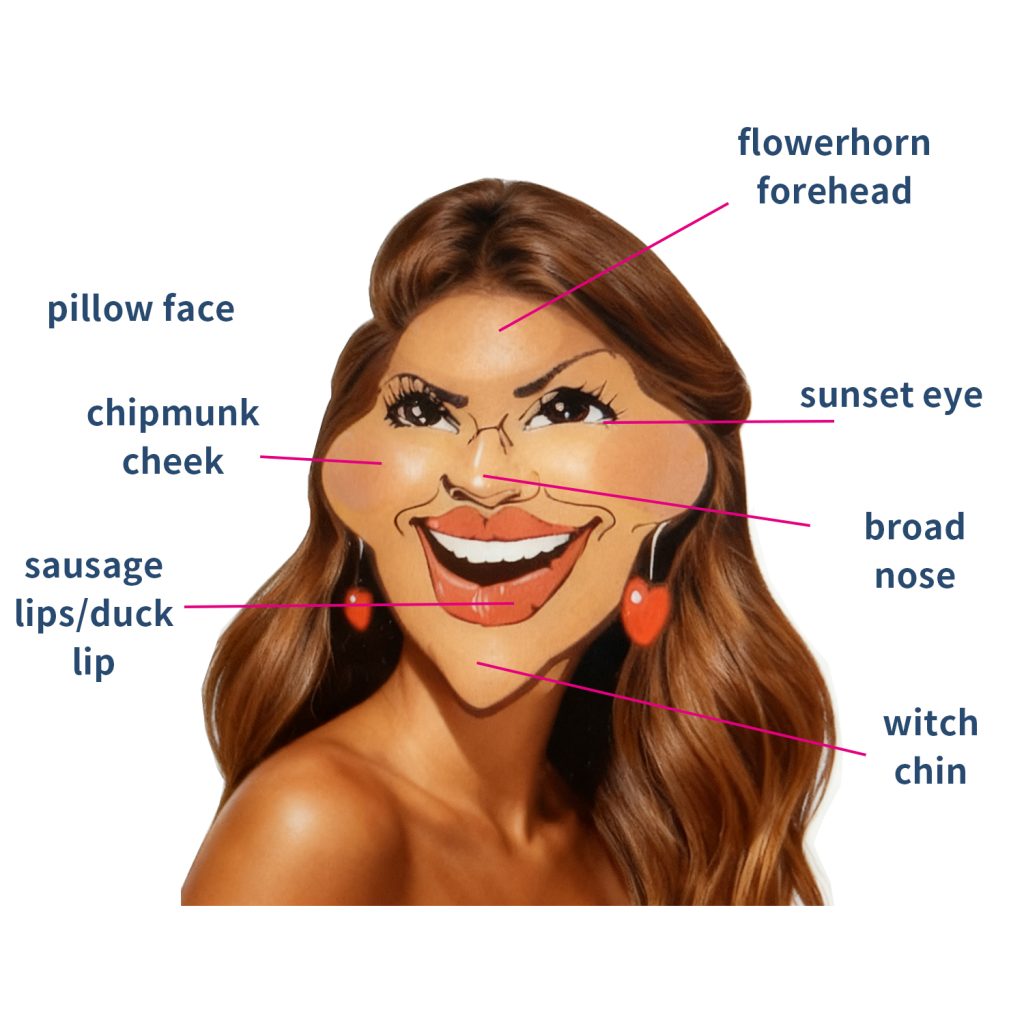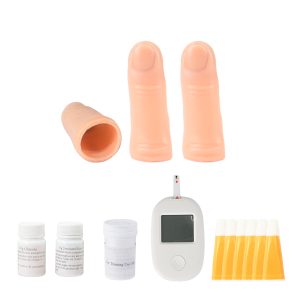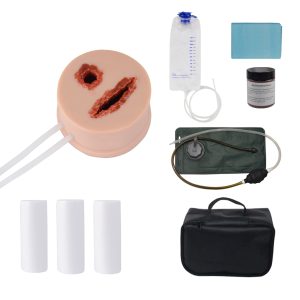The pursuit of a youthful, refreshed appearance has made injectable fillers one of the most sought-after cosmetic treatments. When administered by a skilled practitioner, fillers can restore volume, enhance contours, and soften wrinkles—yielding natural, beautiful results. However, the line between subtle enhancement and obvious distortion is thin. The dreaded”overfilled” look—often mocked on social media—is a real concern for many patients.
This phenomenon, clinically referred to as “Facial Overfilled Syndrome,”encompasses a range of undesirable effects caused by excessive or poorly placed filler. Understanding these distortions—and how to avoid them—is key to ensuring your results remain elegant and natural.
The Most Common Signs of Overfilled Syndrome
1. Duck Lips / Trout Pout / Sausage Lips
What it looks like: Instead of a subtle, natural pout, the lips appear unnaturally large, stiff, and protruding, losing definition and mobility.
Causes:
Overfilling the lips beyond their natural capacity.
Incorrect placement (e.g., injecting too superficially or outside the vermilion border).
Filler migration due to poor technique or excessive movement post-treatment.
How to avoid it:
Start with 0.5ml or less and gradually build volume if needed.
Choose an injector who understands lip anatomy and prioritizes proportion.
2. Flowerhorn Forehead (or “Alien Forehead”)
What it looks like: A bulging, overly rounded forehead with no natural contours, resembling the Flowerhorn fish’s prominent hump.
Causes:
Using dense fillers inappropriately in the forehead.
Overfilling to eliminate wrinkles, resulting in an unnatural convex shape.
How to avoid it:
Opt for minimal filler in this area—sometimes Botox is a better choice for smoothing.
Seek a practitioner skilled in structural facial balancing
3. Flying Saucer Face (Overfilled Cheeks)
What it looks like: The mid-face appears unnaturally round and elevated, like two hard discs implanted in the cheeks.
Causes:
Excessive filler placed superficially in the cheekbones.
Ignoring the natural facial proportions(cheeks should blend seamlessly into temples and jawline).
How to avoid it:
Use hyaluronic acid fillers with lower viscosity for a softer look.
Follow the “less is more”principle—gradual enhancement looks more natural.

4. Chipmunk Cheeks (Pillow Face)
What it looks like: The lower face appears puffy and wide, resembling a chipmunk storing food.
Causes: Overfilling the buccal (cheek) area without considering facial harmony. Using fillers that are too thick or not suited for the mid-face.
How to avoid it:
Focus on lifting rather than adding volume—strategic placement along the cheekbones is key.
Consider Botox in the masseters to slim the lower face before adding filler.(You can find more information from our previous blog on facial muscles)
5. Witch’s Chin (Pointy or Lumpy Chin)
What it looks like: The chin appears unnaturally sharp, protruding, or lumpy.
Causes:
Overfilling the chin without proper structural support.
Using the wrong type of filler (too soft or too dense).
How to avoid it:
Opt for firmer fillers designed for chin augmentation.
Ensure the injector balances the chin with the jawline for a natural transition.
6. Filler Moustache (Migration Above Lips)
What it looks like: A visible bulge above the upper lip, resembling a moustache.
Causes:
Filler migrating due to poor injection technique.
Overfilling the lips, causing product to spread upward.
How to avoid it:
Choose an injector who uses micro-droplet techniques to prevent migration.
Avoid excessive pressure on the lips post-treatment.
7. Sunset Eyes (Eyes Pushed Down by Cheek Filler)
What it looks like: The lower eyelids appear compressed, making the eyes look smaller and “squashed.”
Causes:
Overfilled cheeks pushing upward, distorting the lid-cheek junction.
How to avoid it:
Ensure cheek filler is placed deep on the bone, not superficially.
Consider lower blepharoplasty (surgery) for severe cases instead of filler.
Why Do These Effects Happen? (The Root Causes)
According to Mandal Plastic Surgery Center, the most common reasons for facial distortion from fillers include:
- Practitioner Inexperience
Injecting fillers requires deep knowledge of facial anatomy. A poorly trained injector may place filler in the wrong plane (e.g., superficial instead of deep), leading to unnatural results.
Solution: Always choose a board-certified plastic surgeon or dermatologist with extensive experience in facial aesthetics.
- Over-Treatment (The “More is Better” Myth)
Many patients request excessive filler, thinking it will yield better results. However, subtlety is key—overfilling leads to unnatural puffiness.
Solution: Start with minimal filler and add more only if necessary.
- Wrong Filler Choice
Different facial areas require different filler consistencies. Example: A thick filler meant for cheeks may look lumpy in the lips.
Solution: Discuss filler options with your provider—hyaluronic acid fillers (like Juvéderm or Restylane) are safest because they can be dissolved.
- Ignoring Facial Proportions
A skilled injector considers the entire face, not just one feature. Example: Overfilled lips can throw off balance with the chin and cheeks.
Solution: Seek a practitioner who follows the golden ratio of facial aesthetics.
How to Ensure Natural, Beautiful Results
1. Choose an Expert Injector
Look for a board-certified plastic surgeon or dermatologist with extensive experience in facial fillers.
Ask to see before-and-after photos of their work—do the results look natural?
2. Start Slow & Build Gradually
”Less is more”—begin with a conservative amount (e.g., 0.5ml for lips).
Wait 2-4 weeks before adding more filler to assess results.
3. Use Reversible Fillers (Hyaluronic Acid-Based)
HA fillers (like Juvéderm, Restylane) can be dissolved with hyaluronidase if needed.
Avoid permanent fillers (e.g., silicone, Sculptra) unless absolutely necessary.
4. Consider Combination Treatments
Botox Lip Flip: Creates a subtle pout without filler.
Masseter Botox: Slims the jaw, reducing the need for excessive chin filler.
Thread Lifts: Provides a natural lift without overfilling.
5. Follow Aftercare Instructions
Avoid massaging or pressing treated areas for 24-48 hours.
Sleep on your back to prevent filler displacement.
Final Thoughts: Artistry Over Volume
The best filler results are invisible—people should notice you looking refreshed, not “done.” By choosing a skilled injector, starting conservatively, and prioritizing facial harmony, you can avoid the pitfalls of overfilled syndrome.
Remember: A facial injection mannequin is a key training tool for injectors—ask if your provider uses one to refine their technique before treating real patients.
reference:
https://www.cliqueclinic.com/blog/facial-overfilled-syndrome
https://vivaskinclinics.com/what-causes-duck-lips/
https://www.drrachelho.com/blog/too-much-dermal-fillers-fatigue/

 Blood Glucose Test Trainer
Blood Glucose Test Trainer  Wound Packing Trainer with 2-in-1 Wounds
Wound Packing Trainer with 2-in-1 Wounds